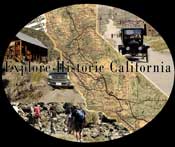|
Since the start of mining operations in Bodie, California,
equipment was driven either by muscle power or steam power. While
there were usually plenty of strong backs willing to work for good
wages, muscle power had its physical limitations. It was steam,
produced by the burning of wood that turned the stamp mills, raised
the ore carts and lowered the men and equipment into the mines.
|
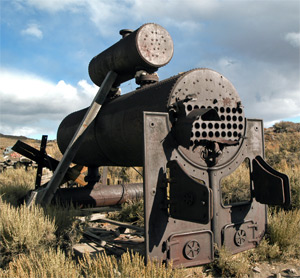 |
| Old
boiler at Bodie. |
Wood was also burned in the residents' uninsulated homes to
provide heat and cook meals.
But wood was a precious commodity in the high country
mining town. The nearest forests were miles away in the Sierras or
south of Mono Lake. Wood had to be hauled on the backs of pack
animals, or in wagons. During the winter months, Bodie was isolated
from wood shipments by 20-foot snow drifts.
The Bodie Railway and Lumber Company was formed in 1881 to
build a rail line from Bodie 32 miles to the Jeffrey pine forest in
the volcanic hills south of Mono Lake. A lumber camp and sawmill
were built at Mono Mills. The mill and the locomotives were, of
course, powered by steam.
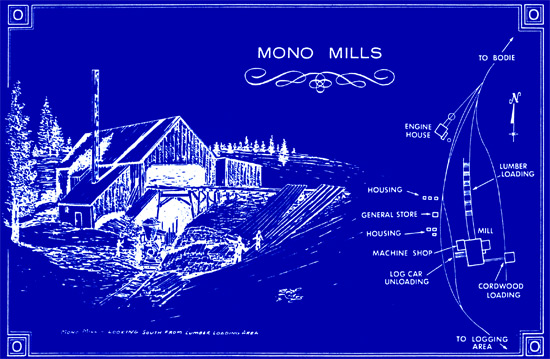 |
|
Drawing of Mono Mills by Robert Likes. |
The railroad operated during the snow-free months of the
year, usually closing down by November and resuming operations in
April. Bodie's fortunes began to decline, ironically, after the
railroad was completed. None the less, the little narrow gauge short
line operated intermittently until 1917. There were even grandiose
plans to connect the line to the Slim Princess (Carson and Colorado)
tracks in Benton.
Mines and mills consolidated operations or closed entirely
as ore bodies played out. Those that survived continued to be
powered by steam.
Thousands of miles away from Bodie, a battle of
technologies was raging that would eventually penetrate Bodie's
remoteness. Thomas Edison and George Westinghouse were waging a war
of words and sparks to achieve dominance in the new field of
electrical transmission.
Edison was convinced that locally generated direct current
(DC) was the power source of the future. Westinghouse, also an
accomplished inventor, realized that DC could not be practically
transmitted over long distances because of voltage drops. He was
convinced alternating current (AC), boosted (transformed) from low
voltage to high voltage for transmission, then transformed back to
low voltage at the point of use, was the solution.
Westinghouse held the U.S. rights for several transformer
designs and acquired outright the rights to Nikola Tesla's polyphase
induction motor designs. By 1890, Westinghouse was selling more than
$4 million worth of AC equipment annually.
Edison's plans for DC distribution were short circuited in
1893 when Westinghouse won the bid to power 180,000 incandescent
lights at the Columbian Exposition in Chicago.
Back in Bodie, steam was still king. Wood was going for $10
per cord and the Standard mill
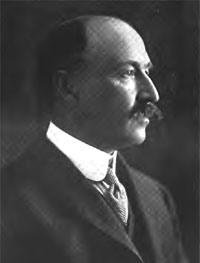 |
|
Thomas
H. Leggett |
was spending $2,000 each month to process 50 tons of ore
daily. The 24-year old superintendent, Thomas Leggett, had read
about a mine in Telluride, Colorado that had installed a
Westinghouse AC electric motor powered by hydroelectric power
generated three miles away.
While Bodie had sufficient water for its mining and
drinking needs, it lacked the volume and flow needed to generate
hydroelectric power. The nearest source was 13 miles away on Green
Creek, south of Bridgeport.
Leggett concluded
that if power could be carried for three miles, it was fairly safe
to try for 13 miles. He consulted with representatives of Edison's
General Electric Co. in San Francisco. "I found that the development
of power-transmission by electricity was in such an early stage that
they were still wedded to the direct current, and little as I knew
about electricity, I felt the uncertainty of the methods they
proposed," Leggett recalled later in an interview.
"I then consulted
W. F. C. Hasson, electrical engineer, graduate of Annapolis, who had
just opened an office in San Francisco-in fact, I had the honor of
being his first client," Leggett said. "This resulted in tying up
with the Westinghouse company, which took the contract to carry the
power for that distance-13 miles-using a 120-kw. generator at the
water-power end, direct-connected with Pelton water-wheels under
300-ft. head, without transformers, the current being generated at
3000 volts and carried on No. 1 bare copper wire, to Bodie, where it
was applied to the operation of the mill."
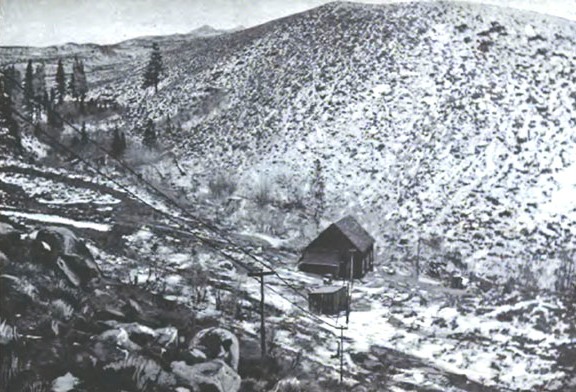 |
| The
Green Creek power house and power lines from Twelfth
Report of the State Mineralogist, 1894 by Thomas H.
Leggett. |
Construction
began in late 1892 on the Green Creek power house, 355 feet below an
old ditch that had been cleaned of debris and fitted with a penstock
and 18 inch diameter pipe. Water was delivered at 152 p.s.i. to the
21-inch Pelton wheels driving a Westinghouse generator producing
3,390-3,530 volts AC.
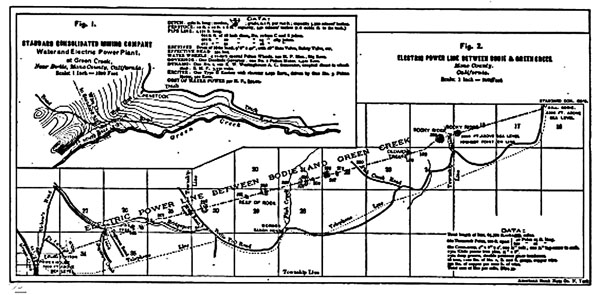 |
|
Diagram of electric power line from Green Creek to
Bodie. |
The boiler and
steam engine had been disconnected and the Standard mill retrofitted
for electric power in mid-1893, idling a number of workers in the
mill and mine. This did not sit well with the idled workers or the
town in general. They refereed to the project as "Leggett's folly"
and went so far as to ostracize his wife, Fanny, from social events.
The electricity
generated at Green Creek was carried over two bare No.1 copper wires
stretched 67,760 feet from the power house to the Standard mill.
The larger diameter No.1 wire was chosen over smaller No. 6 wire
because of its increased strength. The larger wire also
eliminated the need for step-up transformers and simplified the
transmission system's design.
The two bare
wires were supported on 21 foot, 6 inch diameter poles set 4 feet in
the ground. Through town, and in areas of deep snow, 25 foot poles
were used. The poles were
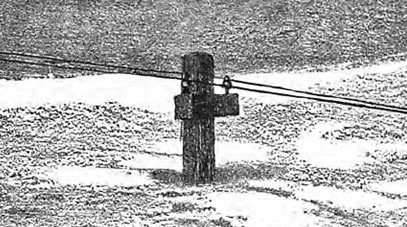 |
| Pole
No. 40; 4,000 feet from mill. Wire is 17 feet above
ground at pole. Snow drift is 15 feet deep (March,
1893). The wires are bare copper and carry 3,100 volts. |
spaced 100 feet
apart and each fitted with a 4 x 6 inch cross arm. The terrain
surrounding Bodie is tough and rocky. Leggett's crew used 500 pounds
of dynamite to blast the pole holes.
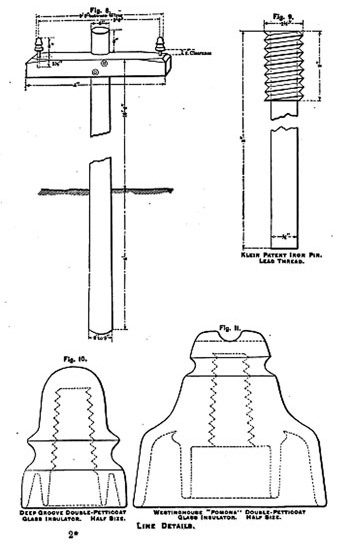 |
|
Power pole and insulators. |
The wires were
attached to deep groove glass insulators. When the electricity
reached Bodie, its potential had been reduced to about 3,100 volts
due to line losses.
Contrary to a
popular story, the power lines were not run straight because
of fears of electricity shooting out the wires at bends. The lines
were run as straight as possible because a straight line is the
shortest distance between two points, thus maximizing the use of
copper wire. Photographs of the original lines show bends and sags
as the lines climbed over hills.
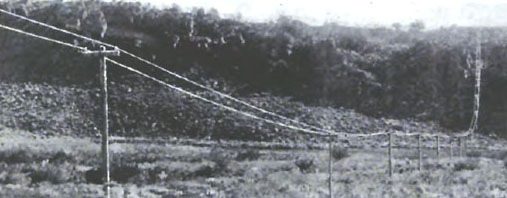 |
|
Summer view of poles 10 miles from Bodie looking west.
Notice how the wires bed is they climb the hill in the
distance. |
Telephone lines
following a different route provided the necessary communication
between the mill and power house to synchronize the generator and
motor.
The Standard mill
and offices were the only buildings on the original electrical
circuit. A 120 h.p. synchronous motor ran the twenty 750 pound stamps,
concentrators, pans, agitators, settlers and machine shop equipment. A transformer stepped
down the voltage to 100 volts for lighting the in mill building and
nearby offices. After a 30 day test period, the system was put
into full operation late in 1893.
|
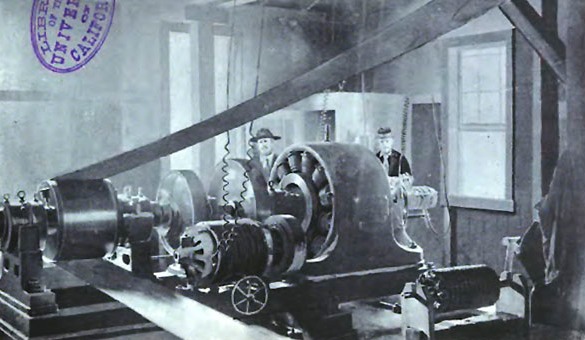 |
|
Motor room in operation at Standard mill. |
The Standard mine
atop the hill still relied on steam power to operate the hoists as
AC motors run at a constant speed and are unsuitable for such use.
After a fire in the mine's hoisting works in 1894, Leggett installed
a DC-powered hoist inside the mine and a DC generator inside the mill.
The rest of the
town, too, still burned wood for fuel, and continued to do so
for the next 17 years until December 24, 1910, when a new
hydroelectric plant at Jordan began supplying power. Unfortunately,
the power from the original Jordan plant lasted only until March 7,
1911 when the entire power plant at the base of Copper Mountain was
erased by an avalanche (see
www.explorehistoricalif.com/december07.html for the story on the
disaster).
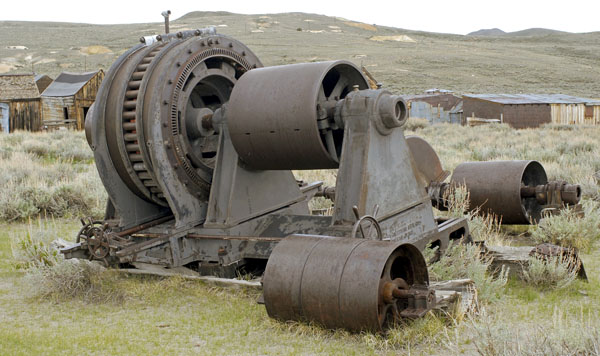 |
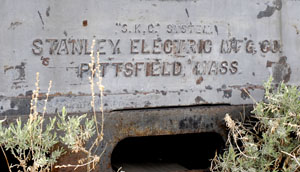 |
A
Stanley Electric Mfg. Co. generator sits near the
entrance to Bodie today. |
Bibliography
Electric Power Transmission Plants and the Use of
Electricity in Mining Operations
by Thomas
Haight Leggett
Written
for the Twelfth Report of the State Mineralogist, 1894
Interviews with Mining Engineers
(interview
with Thomas H. Leggett)
by T. A.
Rickard
Mining and
Scientific Press, 1922
Christmas Delivery at Bodie Sparks Jordan Disaster
by Cecile Page Vargo
Explore Historic
California, December 2007
Developments in Electricity and Bodie’s Long Distance Power
Transmission
by
Michael H. Piatt
http://bodiehistory.com/power.htm
George Westinghouse, Thomas Edison & the Battle of
the Currents
How dead dogs and botched executions helped pave the
way to the power system we enjoy today
by Kevin Jones
http://www.barks.com/2003/03-10hist.html
|
